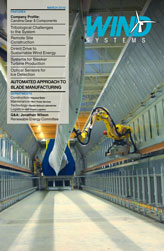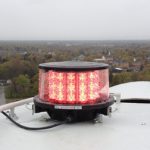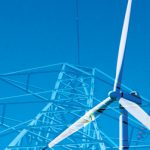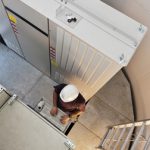The wind turbine blade manufacturing business has quickly blossomed from a cottage industry of highly skilled craftsman to a worldwide industry competing for market share in the global energy market. In the early days the highly labor-intensive approach was not a problem, but as wind turbine manufacturers strive to gain market share against other renewable and non-renewable energy alternatives long-term success can only be achieved by making sure that blade production is world-class.
The good news is that wind turbine blade manufacturers have a golden opportunity to learn from the lessons of other manufacturing industries that faced similar challenges. However, there are no guarantees of how things will work out. Looking at the paths that other industries followed some met the challenge by aggressively driving their organizations to become world-class manufacturing leaders, some met the challenge by moving to countries with low cost labor, and some were never able to meet the challenge and went out of business.
For those that focused on maintaining their existing manufacturing base, there is very often a common thread of effective use of robotics and flexible automation. These companies recognized that the more labor-intensive processes that worked in the early days did not necessarily lend themselves to becoming world-class manufacturing leaders. Those that were successful companies revamped their operations focusing on three key areas
1) Eliminating unnecessary waste and reducing both direct and capital costs;
2) Increasing capacity utilization from existing assets for maximum efficiency;
3) Achieving greater process consistency for the highest possible quality.
Robotics and flexible automation may only be one ingredient in the overall formula for success in achieving the “three Cs,” but it is nonetheless a critical enabler that allowed these companies to redefine themselves. Although still in the early stages, wind turbine blade manufacturers are beginning to embrace robotics and flexible automation and move along the path of world class manufacturing leadership within their existing operations.
One good example is in the processing of the root end of the blade. The specific operations vary by blade manufacturer but can include cutting off excess material from the root end, milling the root face, drilling axial holes, and drilling radial holes. These operations have been traditionally handled by CNC equipment. CNC root processing systems get the job done but have several shortcomings including machine availability, flexibility, and last but not least, cost. This is because blades must be precisely positioned to insure that facing of the root end and both the axial and radial holes are within the required tolerances. Not only does this require a skilled operator to position these multi-ton blades, loading time is idle time for a relatively expensive piece of capital equipment.
KMT Robotic Solutions developed its patent-pending AccuFind technology to quickly and precisely locate the root end of wind turbine blades. “Our approach to root end cut and drill was to leverage our experience in automating the trimming of large composite parts,” according to Chuck Abrams, development manager. “We use this technology to quickly locate the root end center and, when desired by the manufacturer, to locate the entire blade in 3D space so that the blade length and zero pitch offset can be determined.”
KMT’s root end cut and drill solution addresses the three Cs by reducing blade setup time, increasing system uptime, allowing for handling of multiple blade types, and reducing total system cost, of course. As demand for wind turbines continues to grow, manufacturers continue to look for cost-effective ways to meet this increased demand within their existing facilities while still achieving high quality and precision. Those who justify the purchase of robotic root end processing systems based on the lower cost and higher throughput then find that the extremely high uptime and ease of setup and operation eliminated the hidden downtime and disruptions of their prior solutions.
Some of the most challenging processes to automate are trimming of the flash and sanding of the blade surface. These processes must deal with the challenges of fixturing and locating blades that are flexible with future blades continuing to grow larger. This combined with surface and edge finishes that can vary from blade to blade make automating these operations a challenge. EINA of Pamplona, Spain, has met the sanding challenge with an innovative tooling concept that finds and tracks to the varying contour of wind turbine blades.
fig. 2
“Wind turbine blades can be up to 50m, making them difficult to precisely fixture, and their complex geometries make them difficult to program,” says Jorge Castillo, general manager of EINA. “Our robotic sanding head is designed to make sure that the sanding tool is always perpendicular to the surface of the blade. This allows our customers to simply program the starting and ending point for each sanding path and let the robot handle the details.”
The EINA tooling provides a cost-effective solution for one of the most labor-intensive operations in the manufacturing of wind turbine blades. The consistent performance of the robot also improves surface quality and reduces rework.
KMT Robotic Solutions has developed a unique solution for tracking and trimming the left over flash from the molding process, one that simultaneously locates the flash to blade transition while trimming the flash. The KMT solution requires only a single pass to trim and retains the seam location for a second pass grinding operation. As with sanding, the robotic flash trimming solution provides a cost effective alternative to manual trimming while improving overall blade quality and reducing rework.
One of the last steps in the post molding process is painting the wind turbine blades. Alpha-Tec of Ludwigsburg-Pflugfelden, Germany, recently installed a dual eight-axis robot system that handles everything from cleaning and activating the blade surface to applying a gel coat and top coat, to drying the paint on wind turbine blades. All of these operations are completed in a single booth that can handle the full blade manufacturing capacity for a typical plant. Heinz Handke, manager of sales and engineering for Alpha-Tec, says that “by combining all of these operations we are able to reduce the total floor space required as well as the overall capital investment while still meeting the required production capacity. We believe that our recently installed system is the only production operation in the world that combines all of these operations. The Alpha-Tec solution also reduces the amount of paint required and the overall energy costs, providing further cost savings for our customers.”
fig. 3
Alpha-Tec is able to accomplish this by using an innovative optical measurement system to locate the blade and adjust the robot path to both minimize wasted paint and maximize overall finish quality.
This is just a sampling of the progress being made in robotics in flexible automation. Areas like glass layup and inspection are also benefitting by advances in robotics and flexible automation. The key is to begin to move forward on the path toward success in the three Cs, including greater use of robotics and flexible automation or risk facing less desirable alternatives. Jack Welch, the former CEO of General Electric, elegantly laid out the three alternatives his manufacturing business units faced, which were to “automate, emigrate, or evaporate.” This holds as true today for wind turbine blade manufacturers as it did then for GE.








































